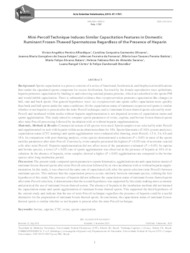Mini-percoll technique induces Similar capacitation features in domestic ruminant frozen-thawed spermatozoa regardless of the presence of heparin.
Mini-percoll technique induces Similar capacitation features in domestic ruminant frozen-thawed spermatozoa regardless of the presence of heparin.
Autoria: ALFRADIQUE, V. A. P.; OLIVARES, C. C. S.; SOUZA-FABJAN, J. M. G. de; FONSECA, J. F. da; BATISTA, R. I. T. P.; BALARO, M. F. A.; SARAIVA, H. F. R. de A.; CÔRTES, L. R.; BRANDÃO, F. Z.
Resumo: Background: Sperm capacitation is a process consists of a series of functional, biochemical, and biophysical modifications that render the ejaculated sperm competent for oocyte fertilization. Secreted by the female reproductive tract epithelium, heparin promotes capacitation by binding to and removing seminal plasma proteins, which are adsorbed to the sperm PM and would inhibit capacitation. There is substantial evidence that cryopreservation promotes capacitation-like changes in bull, ram and buck sperm. Our general hypotheses were: (a) cryopreserved ram sperm suffer capacitation more quickly than buck and bull sperm under the same conditions; (b) the capacitation status of ruminant cryopreserved sperm is similar whether or not heparin is present after the mini-Percoll technique; and (c) ruminant frozen-thawed sperm selected by mini-Percoll and incubated within media without heparin supplementation is not impaired in terms of capacitation status and sperm agglutination. This study aimed to compare sperm parameters of ovine, caprine, and bovine frozen-thawed sperm after mini-Percoll processing followed by incubation with or without heparin supplementation. Materials, Methods & Results: Commercial semen of all species were used. Sperm samples were selected by mini-Percoll and supplemented (or not) with heparin within an incubation medium for 18 h. Sperm kinematics (CASA system analyzes), capacitation status (CTC staining) and sperm agglutination were evaluated after thawing, mini-Percoll, 1.5 h, 3 h, 6 h and 18 h. In comparison with post-thawing analysis, ovine species demonstrated a reduction (P < 0.05) in most of the sperm motility parameters after mini-Percoll. Conversely, ovine samples presented the highest (P < 0.05) rate of acrosome-reacted cells after mini-Percoll. Heparin supplementation did not affect most of the parameters evaluated (P > 0.05). In caprine and bovine species, a lower (P < 0.05) rate of sperm agglutination was observed in the presence of heparin at 18 h of incubation. In the absence of heparin, ovine samples showed a higher (P < 0.05) agglutination rate compared to the bovine species after long incubation period. Discussion: The present study compared sperm parameters (sperm kinematics, agglutination rate and capacitation status) of ruminant frozen-thawed sperm after mini-Percoll selection followed by in vitro incubation with or without heparin supplementation. In this study, it was observed the same rate of capacitated cells after the sperm selection (min-Percoll) between ruminant species. This indicate that the capacitation process occurs similarly between ruminant species, refuting the first hypothesis of this study. The presence of heparin did not influence the capacitation status of ruminant frozen-thawed sperm after mini-Percoll selection, it demonstrates that the second hypothesis was supported by this study making more economic and practical the use of ruminant frozen-thawed semen. The absence of heparin in the incubation medium did not harmed the capacitation status and sperm agglutination of ruminant frozen-thawed sperm. This supported the third hypothesis of the current study and indicate that the use of mini-Percoll technique regardless the presence of heparin could be a useful alternative for the preparation of ruminant frozen-thawed sperm. In conclusion, the capacitation status of ruminant frozen-thawed sperm is similar whether or not heparin is present after the mini-Percoll technique.
Ano de publicação: 2019
Tipo de publicação: Artigo de periódico
Unidade: Embrapa Caprinos e Ovinos
Palavras-chave: Animal reproduction, Assisted reproductive technologies, Billygoats, Bode, Bovino, Bulls, CTC, Caprino, Carneiro, Cattle, Espermatozóide, Goats, Heparin, Heparina, Ovino, Rams, Reprodução Animal, Sheep, Sperm capacitation, Sêmen
Observações
1 - Por padrão são exibidas publicações dos últimos 20 anos. Para encontrar publicações mais antigas, configure o filtro ano de publicação, colocando o ano a partir do qual você deseja encontrar publicações. O filtro está na coluna da esquerda na busca acima.
2 - Para ler algumas publicações da Embrapa (apenas as que estão em formato ePub), é necessário ter, no celular ou computador, um desses softwares gratuitos. Sistemas Android: Google Play Livros; IOS: iBooks; Windows e Linux: software Calibre.
Acesse outras publicações
Acesse a Base de Dados da Pesquisa Agropecuária (BDPA) para consultar o acervo completo das bibliotecas da Embrapa.

